eng MAZDA MODEL CX-9 2018 (in English) User Guide
[x] Cancel search | Manufacturer: MAZDA, Model Year: 2018, Model line: MODEL CX-9, Model: MAZDA MODEL CX-9 2018Pages: 640
Page 33 of 640
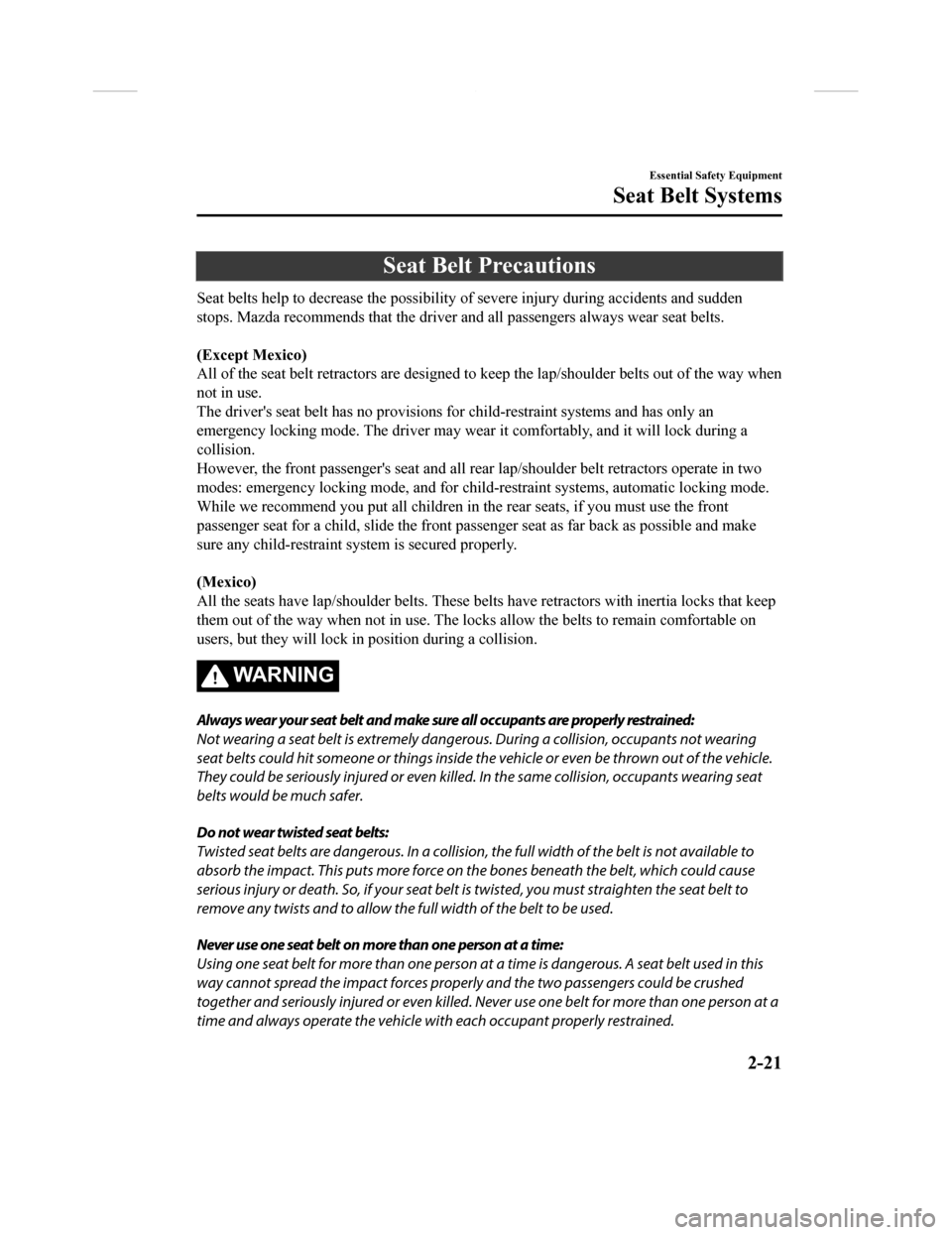
Seat Belt Precautions
Seat belts help to decrease the possibility of severe injury during accidents and sudden
stops. Mazda recommends that the driver and all passengers alwa ys wear seat belts.
(Except Mexico)
All of the seat belt retractors are designed to keep the lap/sh oulder belts out of the way when
not in use.
The driver's seat belt has no pr ovisions for child-restraint systems and has only an
emergency locking mode. The driver may wear it comfortably, and it will lock during a
collision.
However, the front passenger's s eat and all rear lap/shoulder belt retractors operate in two
modes: emergency locking mode, and for child-restraint systems, automatic locking mode.
While we recommend you put all children in the rear seats, if y ou must use the front
passenger seat for a child, slide the front passenger seat as far back as possible and make
sure any child-restraint sy stem is secured properly.
(Mexico)
All the seats have lap/shoulder belts. These belts have retract ors with inertia locks that keep
them out of the way when not in use. The locks allow the belts to remain comfortable on
users, but they will lock in position during a collision.
WA R N I N G
Always wear your seat belt and make sure all occupants are properly restrained:
Not wearing a seat belt is extremely dangerou s. During a collision, occupants not wearing
seat belts could hit someone or things inside the vehicle or even be thrown out of the vehicle.
They could be seriously injured or even killed. In the same collision, occupants wearing seat
belts would be much safer.
Do not wear twisted seat belts:
Twisted seat belts are dangerous. In a collision, the full width of the belt is not available to
absorb the impact. This puts more force on the bones beneath the belt, which could cause
serious injury or death. So, if your seat belt is twisted, you must straighten the seat belt to
remove any twists and to allow the fu ll width of the belt to be used.
Never use one seat belt on more than one person at a time:
Using one seat belt for more than one person at a time is dangerous. A seat belt used in this
way cannot spread the impact forces properly and the two passengers could be crushed
together and seriously injured or even killed. Ne ver use one belt for more than one person at a
time and always operate the vehicle wi th each occupant properly restrained.
Essential Safety Equipment
Seat Belt Systems
2-21
CX-9_8GC3-EA-17G_Edition1 2017-5-29 10:13:38
Page 35 of 640
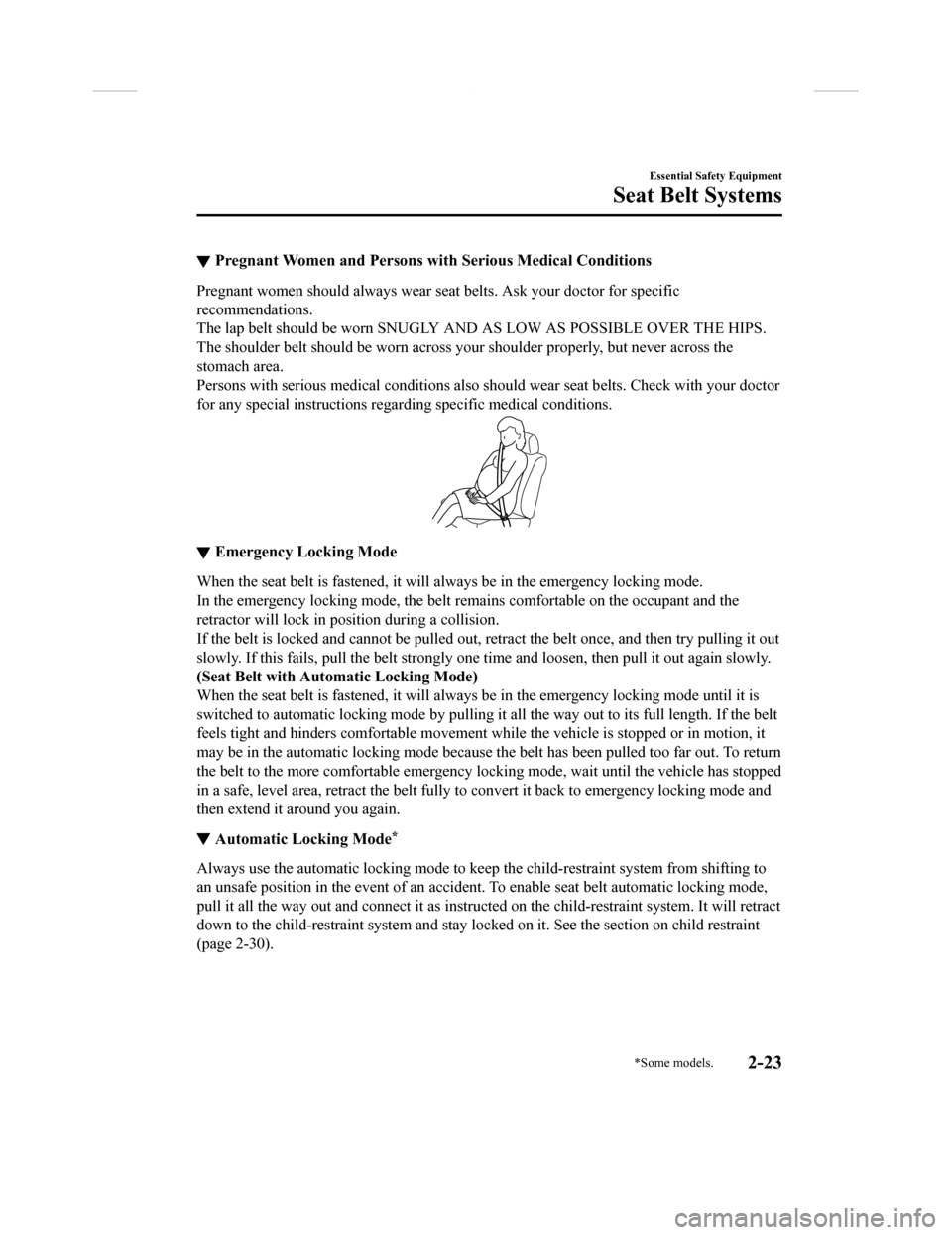
▼Pregnant Women and Persons wi
th Serious Medical Conditions
Pregnant women should always wear seat belts. Ask your doctor f or specific
recommendations.
The lap belt should be worn SNUGL Y AND AS LOW AS POSSIBLE OVER THE HIPS.
The shoulder belt should be worn across your shoulder properly, but never across the
stomach area.
Persons with serious medical conditions also should wear seat b elts. Check with your doctor
for any special instructions regarding specific medical conditi ons.
▼Emergency Locking Mode
When the seat belt is fastened,
it will always be in the emergency locking mode.
In the emergency locking mode, the belt remains comfortable on the occupant and the
retractor will lock in position during a collision.
If the belt is locked and cannot be pulled out, retract the belt once, and then try pulling it out
slowly. If this fails, pull the belt strongly one time and loos en, then pull it out again slowly.
(Seat Belt with Auto matic Locking Mode)
When the seat belt is fastened, it will always be in the emergency locking mode until it is
switched to automatic locking mode by pulling it all the way ou t to its full length. If the belt
feels tight and hinders comfortabl e movement while the vehicle is stopped or in motion, it
may be in the automatic locking mode because the belt has been pulled too far out. To return
the belt to the more c omfortable emergency locking mode, wait until the vehicle has stopped
in a safe, level area, retract the belt fully to convert it bac k to emergency locking mode and
then extend it around you again.
▼ Automatic Locking Mode*
Always use the automatic locking mode to keep the child-restrai
nt system from shifting to
an unsafe position in the event of an accident. To enable seat belt automatic locking mode,
pull it all the way out and connect it as instructed on the chi ld-restraint system. It will retract
down to the child-res traint system and stay locked on it. See t he section on child restraint
(page 2-30).
Essential Safety Equipment
Seat Belt Systems
*Some models.2-23
CX-9_8GC3-EA-17G_Edition1 2017-5-29 10:13:38
Page 38 of 640
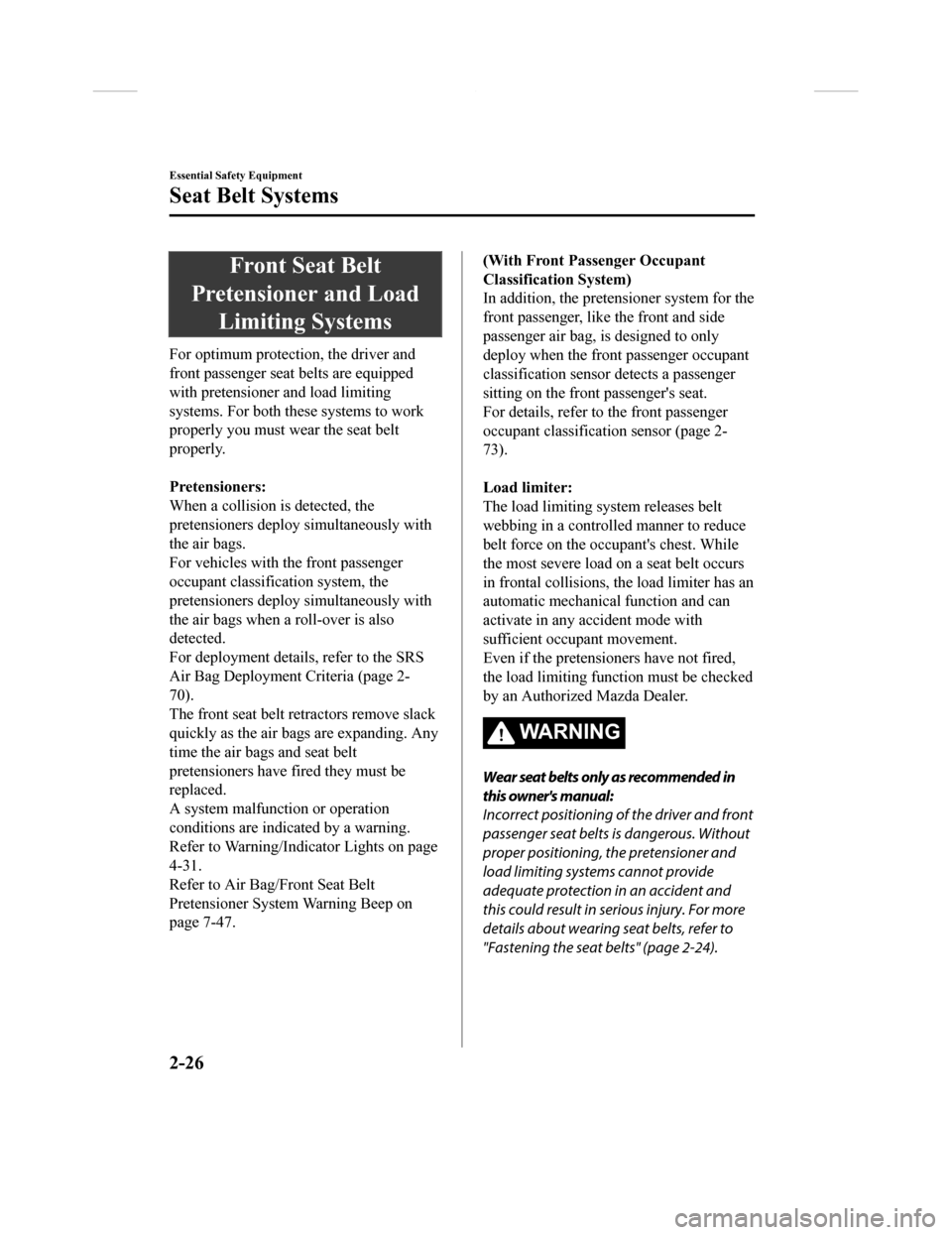
Front Seat Belt
Pretensioner and Load Limiting Systems
For optimum protection, the driver and
front passenger seat belts are equipped
with pretensioner and load limiting
systems. For both these systems to work
properly you must wear the seat belt
properly.
Pretensioners:
When a collision is detected, the
pretensioners deploy simultaneously with
the air bags.
For vehicles with t he front passenger
occupant classification system, the
pretensioners deploy simultaneously with
the air bags when a roll-over is also
detected.
For deployment details, refer to the SRS
Air Bag Deployment Criteria (page 2-
70).
The front seat belt retractors remove slack
quickly as the air bags are expanding. Any
time the air bags and seat belt
pretensioners have fired they must be
replaced.
A system malfunction or operation
conditions are indicated by a warning.
Refer to Warning/Indicator Lights on page
4-31.
Refer to Air Bag/Front Seat Belt
Pretensioner System Warning Beep on
page 7-47.
(With Front Passenger Occupant
Classification System)
In addition, the pretensioner system for the
front passenger, like the front and side
passenger air bag, is designed to only
deploy when the front passenger occupant
classification sensor detects a passenger
sitting on the front passenger's seat.
For details, refer to the front passenger
occupant classification sensor (page 2-
73).
Load limiter:
The load limiting system releases belt
webbing in a controlled manner to reduce
belt force on the occupant's chest. While
the most severe load on a seat belt occurs
in frontal collisions, th e load limiter has an
automatic mechanical function and can
activate in any accident mode with
sufficient occupant movement.
Even if the pretensioners have not fired,
the load limiting function must be checked
by an Authorized Mazda Dealer.
WA R N I N G
Wear seat belts only as recommended in
this owner's manual:
Incorrect positioning of the driver and front
passenger seat belts is dangerous. Without
proper positioning, the pretensioner and
load limiting systems cannot provide
adequate protection in an accident and
this could result in serious injury. For more
details about wearing seat belts, refer to
"Fastening the seat belts" (page 2-24).
Essential Safety Equipment
Seat Belt Systems
2-26
CX-9_8GC3-EA-17G_Edition1 2017-5-29 10:13:38
Page 40 of 640
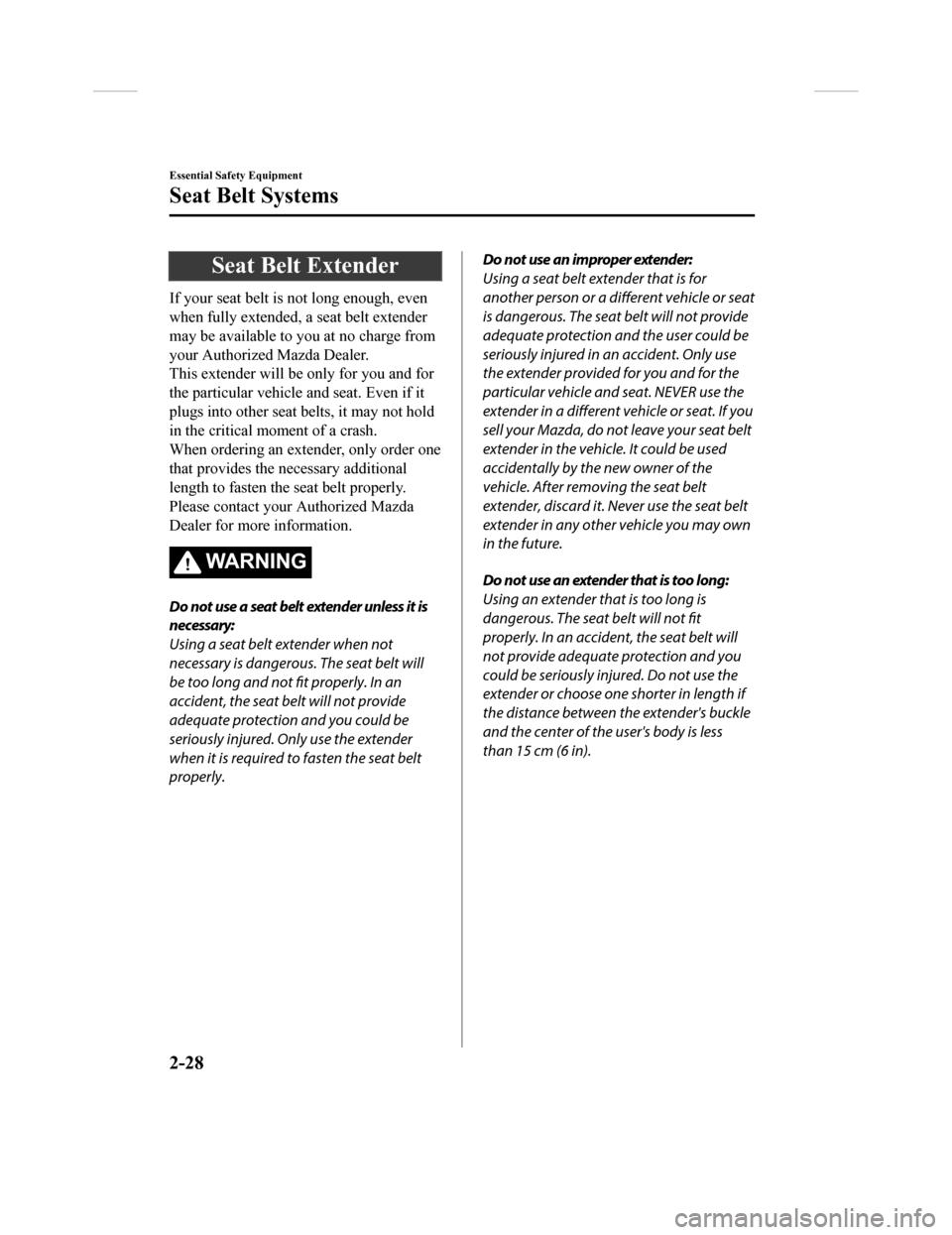
Seat Belt Extender
If your seat belt is not long enough, even
when fully extended, a seat belt extender
may be available to you at no charge from
your Authorized Mazda Dealer.
This extender will be only for you and for
the particular vehicle and seat. Even if it
plugs into other seat belts, it may not hold
in the critical mom ent of a crash.
When ordering an extender, only order one
that provides the necessary additional
length to fasten the seat belt properly.
Please contact your Authorized Mazda
Dealer for more information.
WA R N I N G
Do not use a seat belt extender unless it is
necessary:
Using a seat belt extender when not
necessary is dangerous. The seat belt will
be too long and not fit properly. In an
accident, the seat belt will not provide
adequate protection and you could be
seriously injured. Only use the extender
when it is required to fasten the seat belt
properly.
Do not use an improper extender:
Using a seat belt extender that is for
another person or a different vehicle or seat
is dangerous. The seat belt will not provide
adequate protection and the user could be
seriously injured in an accident. Only use
the extender provided for you and for the
particular vehicle and seat. NEVER use the
extender in a different vehicle or seat. If you
sell your Mazda, do not leave your seat belt
extender in the vehicle. It could be used
accidentally by the new owner of the
vehicle. After removing the seat belt
extender, discard it. Never use the seat belt
extender in any other vehicle you may own
in the future.
Do not use an extender that is too long:
Using an extender that is too long is
dangerous. The seat belt will not fit
properly. In an accident, the seat belt will
not provide adequate protection and you
could be seriously injured. Do not use the
extender or choose one shorter in length if
the distance between the extender's buckle
and the center of the user's body is less
than 15 cm (6 in).
Essential Safety Equipment
Seat Belt Systems
2-28
CX-9_8GC3-EA-17G_Edition1 2017-5-29 10:13:38
Page 41 of 640

Do not leave a seat belt extender
connected to the buckle:
Leaving a seat belt extender connected to
the buckle without using the seat belt is
dangerous. When the seat belt extender is
connected to the driver's seat belt buckle
(or front passenger's seat belt buckle), the
SRS driver's (or front passenger's) air bag
system will determine that the driver (or
front passenger) is wearing the seat belt
even if the driver (or front passenger) is not
wearing it. This condition could cause the
driver's (or front passenger's) air bag to not
activate correctly and result in death or
serious injury in the event of collision.
Always wear the seat belt with the seat belt
extender.
Do not use the seat belt extender when
installing a child-restraint system on the
front or rear passenger seat:
Using a seat belt extender to fasten a
child-restraint system on any seat is
dangerous. Always follow the
child-restraint system manufacturer's
installation instructions and never use a
seat belt extender.
NOTE
When not in use, remove the seat belt
extender and store it in the vehicle. If the
seat belt extender is left connected, the
seat belt extender might get damaged as it
will not retract with the rest of the seat belt
and can easily fall out of the door when
not in use and be damaged. In addition,
the seat belt warning light will not
illuminate and function properly.
Essential Safety Equipment
Seat Belt Systems
2-29
CX-9_8GC3-EA-17G_Edition12017-5-29 10:13:38
Page 42 of 640
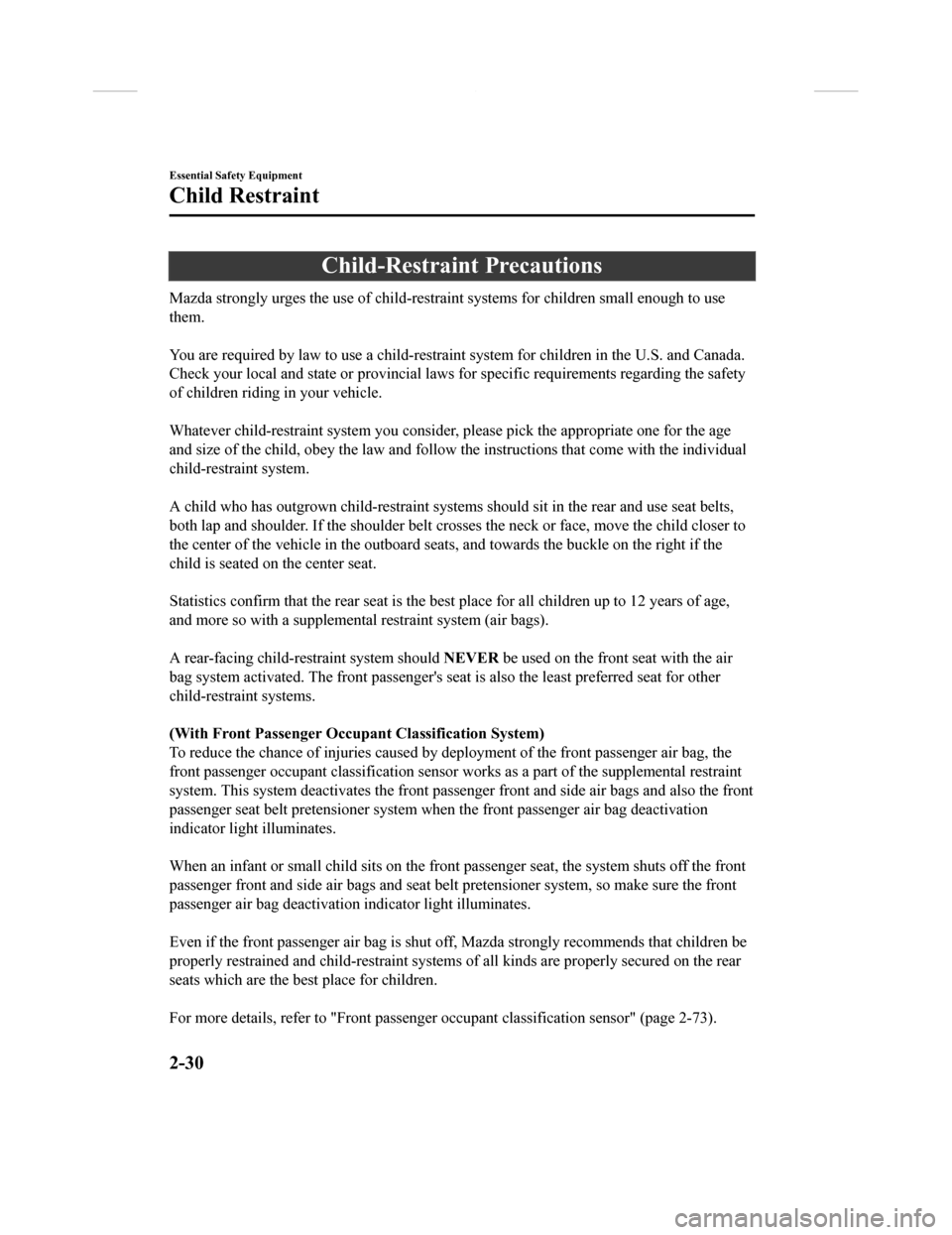
Child-Restraint Precautions
Mazda strongly urges the use of child-restraint systems for children small enough to use
them.
You are required by law to use a child-restraint system for children in the U.S. and Canada.
Check your local and state or provincial laws for specific requ irements regarding the safety
of children riding in your vehicle.
Whatever child-restraint system y ou consider, please pick the appropriate one for the age
and size of the child, obey the law and follow the instructions that come with the individual
child-restraint system.
A child who has outgrown child-r estraint systems should sit in the rear and use seat belts,
both lap and shoulder. If the shoulder belt crosses the neck or face, move the child closer to
the center of the vehicle in the outboard seats, and towards the buckle on the right if the
child is seated on the center seat.
Statistics confirm that the rear seat is the best place for all children up to 12 years of age,
and more so with a supplemental restraint system (air bags).
A rear-facing child-restraint system should NEVER be used on the front seat with the air
bag system activated. The front passenger's seat is also the le ast preferred seat for other
child-restraint systems.
(With Front Passenger Occupa nt Classification System)
To reduce the chance of injuries caused by deployment of the fr ont passenger air bag, the
front passenger occupant classification sensor works as a part of the supplemental restraint
system. This system deactivates the front passenger front and side air bags and also the front
passenger seat belt pretensioner system when the front passenge r air bag deactivation
indicator light illuminates.
When an infant or small child sits on the front passenger seat, the system shuts off the front
passenger front and side air bags and seat belt pretensioner sy stem, so make sure the front
passenger air bag deactivation indicator light illuminates.
Even if the front passenger air bag is shut off, Mazda strongly recommends that children be
properly restrained and child-rest raint systems of all kinds are properly secured on the rear
seats which are the best place for children.
For more details, refer to "Front passenger occupant classification sensor" (page 2-73).
Essential Safety Equipment
Child Restraint
2-30
CX-9_8GC3-EA-17G_Edition1 2017-5-29 10:13:38
Page 43 of 640
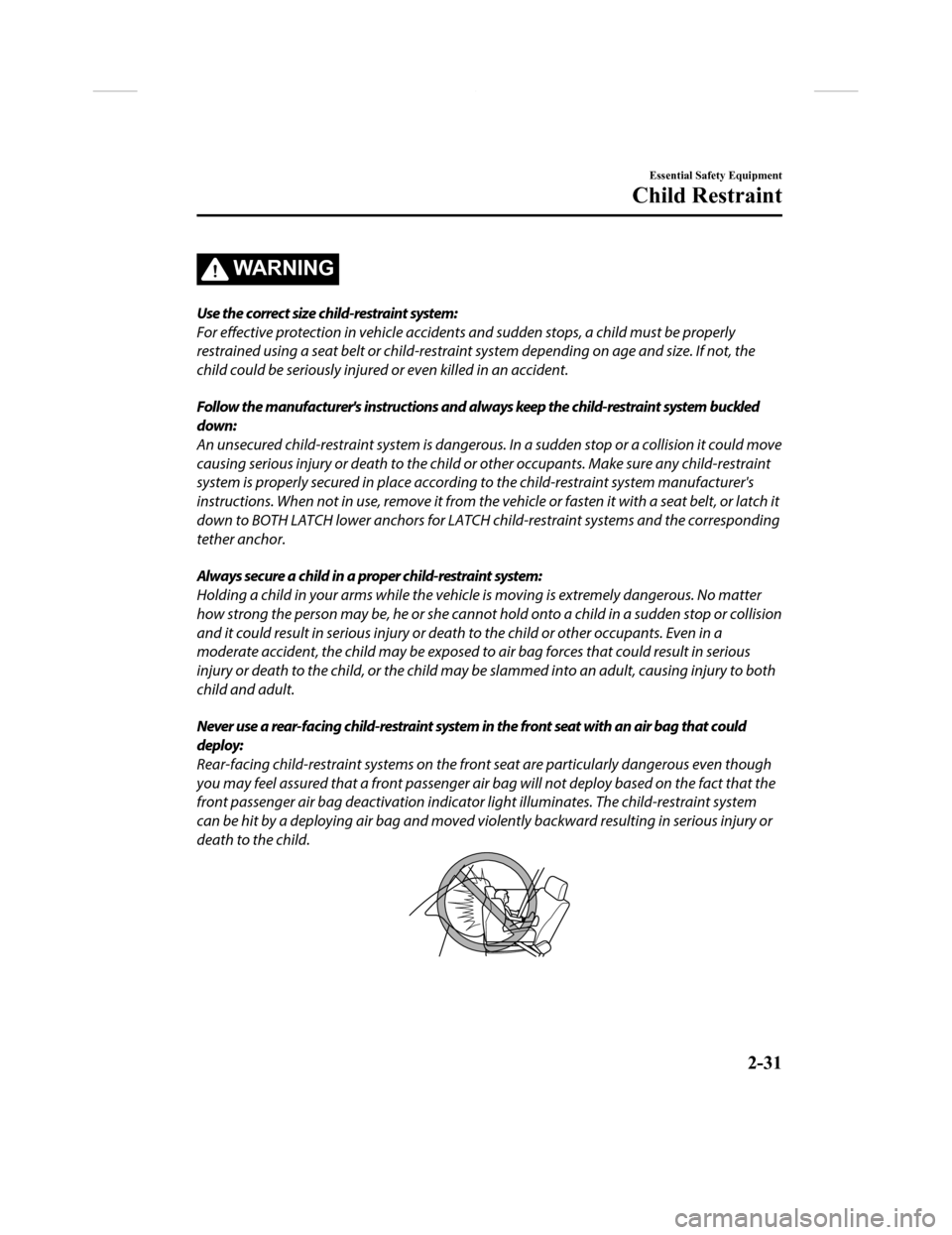
WA R N I N G
Use the correct size child-restraint system:
For effective protection in vehicle accidents and sudden stop s, a child must be properly
restrained using a seat belt or child-restraint system depending on age and size. If not, the
child could be seriously injured or even killed in an accident.
Follow the manufacturer's instructions and always keep the child-restraint system buckled
down:
An unsecured child-restraint system is dangerous . In a sudden stop or a collision it could move
causing serious injury or death to the child or other occupants. Make sure any child-restraint
system is properly secured in place accordin g to the child-restraint system manufacturer's
instructions. When not in use, remove it from the vehicle or fasten it with a seat belt, or latch it
down to BOTH LATCH lower anchors for LATCH child-restraint systems and the corresponding
tether anchor.
Always secure a child in a proper child-restraint system:
Holding a child in your arms while the vehicl e is moving is extremely dangerous. No matter
how strong the person may be, he or she cannot hold onto a child in a sudden stop or collision
and it could result in serious injury or death to the child or other occupants. Even in a
moderate accident, the child may be exposed to air bag forces that could result in serious
injury or death to the child, or the child may be slammed into an adult, causing injury to both
child and adult.
Never use a rear-facing child-restraint system in the front seat with an air bag that could
deploy:
Rear-facing child-restraint systems on the front seat are particularly dangerous even though
you may feel assured that a front passenger air bag will not deploy based on the fact that the
front passenger air bag deactivation indicato r light illuminates. The child-restraint system
can be hit by a deploying air bag and moved viol ently backward resulting in serious injury or
death to the child.
Essential Safety Equipment
Child Restraint
2-31
CX-9_8GC3-EA-17G_Edition1 2017-5-29 10:13:38
Page 44 of 640
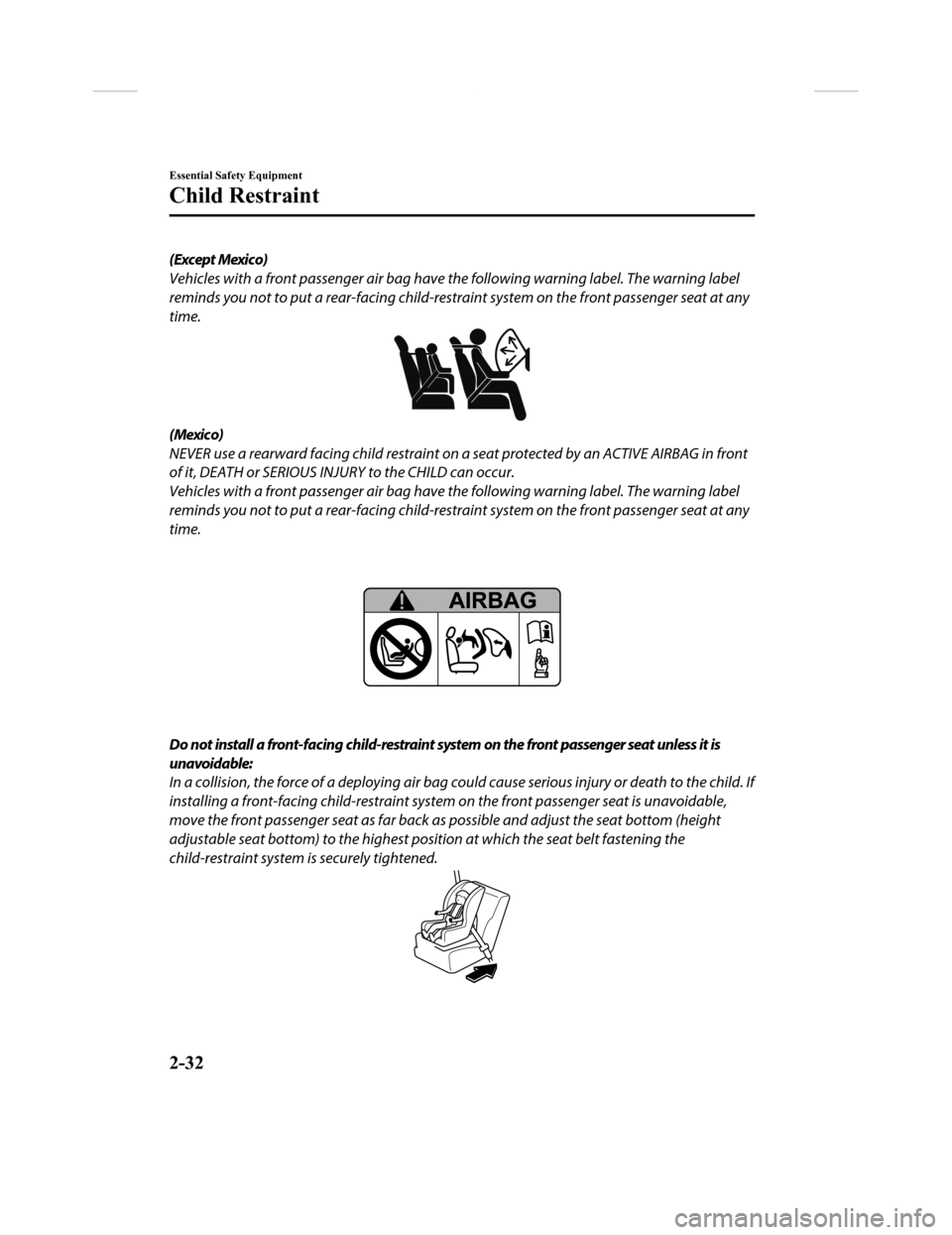
(Except Mexico)
Vehicles with a front passenger air bag have the following warning label. The warning label
reminds you not to put a rear-facing child-restra int system on the front passenger seat at any
time.
(Mexico)
NEVER use a rearward facing child restraint on a seat protected by an ACTIVE AIRBAG in front
of it, DEATH or SERIOUS INJURY to the CHILD can occur.
Vehicles with a front passenger air bag have th e following warning label. The warning label
reminds you not to put a rear-facing child-restra int system on the front passenger seat at any
time.
Do not install a front-facing child-restraint system on the front passenger seat unless it is
unavoidable:
In a collision, the force of a deploying air bag co uld cause serious injury or death to the child. If
installing a front-facing child-restraint system on the front passenger seat is unavoidable,
move the front passenger seat as far back as possible and adjust the seat bottom (height
adjustable seat bottom) to the highest posi tion at which the seat belt fastening the
child-restraint system is securely tightened.
Essential Safety Equipment
Child Restraint
2-32
CX-9_8GC3-EA-17G_Edition1 2017-5-29 10:13:38
Page 45 of 640

Seating a child in a child-restraint system on the front passenger seat is dangerous under
certain conditions (With Front Passenger Occupant Classification System):
Your vehicle is equipped with front passenger occupant classification sensor. Even with the
front passenger occupant classification sensor, if you must use the front passenger seat to
seat a child, using a child-restraint system on the front passenger seat under the following
conditions increases the danger of the front passenger air bag deploying and could result in
serious injury or death to the child.
The front passenger air bag deactivation indicator light does not illuminate when seating a
child in the child-restraint system.
Luggage or other items are placed on the seat with the child in the child-restraint system.
A rear passenger or luggage pushing or pulling down on the front passenger seatback.
Luggage or other items are placed on the seatback or hung on the head restraint.
The seat is washed.
Liquids are spilled on the seat.
The front passenger seat is moved backward, pushing into luggage or other items placed
behind it.
The front passenger seatback contacts the rear seat.
Luggage or other items are placed between the front passenger seat and driver seat.
An electric device is put on the front passenger's seat.
An additional electrical device, such as a seat warmer is installed to the surface of the front
passenger seat.
The designated positions with seat belts on the rear seats are the safest places for children.
Always use seat belts and child restraints.
Do not allow a child or anyone to lean over or against the side window of a vehicle with side
and curtain air bags:
It is dangerous to allow anyone to lean over or against the side window, the area of the front
passenger seat, the front and rear window pillar s and the roof edge along both sides from
which the side and curtain air bags deploy, even if a child-restraint system is used. The impact
of inflation from a side or curtain air bag could cause serious injury or death to an out of
position child. Furthermore, le aning over or against the front door could block the side and
curtain air bags and eliminate th e advantages of supplemental protection. With the front air
bag and the additional side air bag that comes out of the front seat, the rear seat is always a
better location for children. Take special care not to allow a child to lean over or against the
side window, even if the child is seated in a child-restraint system.
Essential Safety Equipment
Child Restraint
2-33
CX-9_8GC3-EA-17G_Edition1 2017-5-29 10:13:38
Page 46 of 640
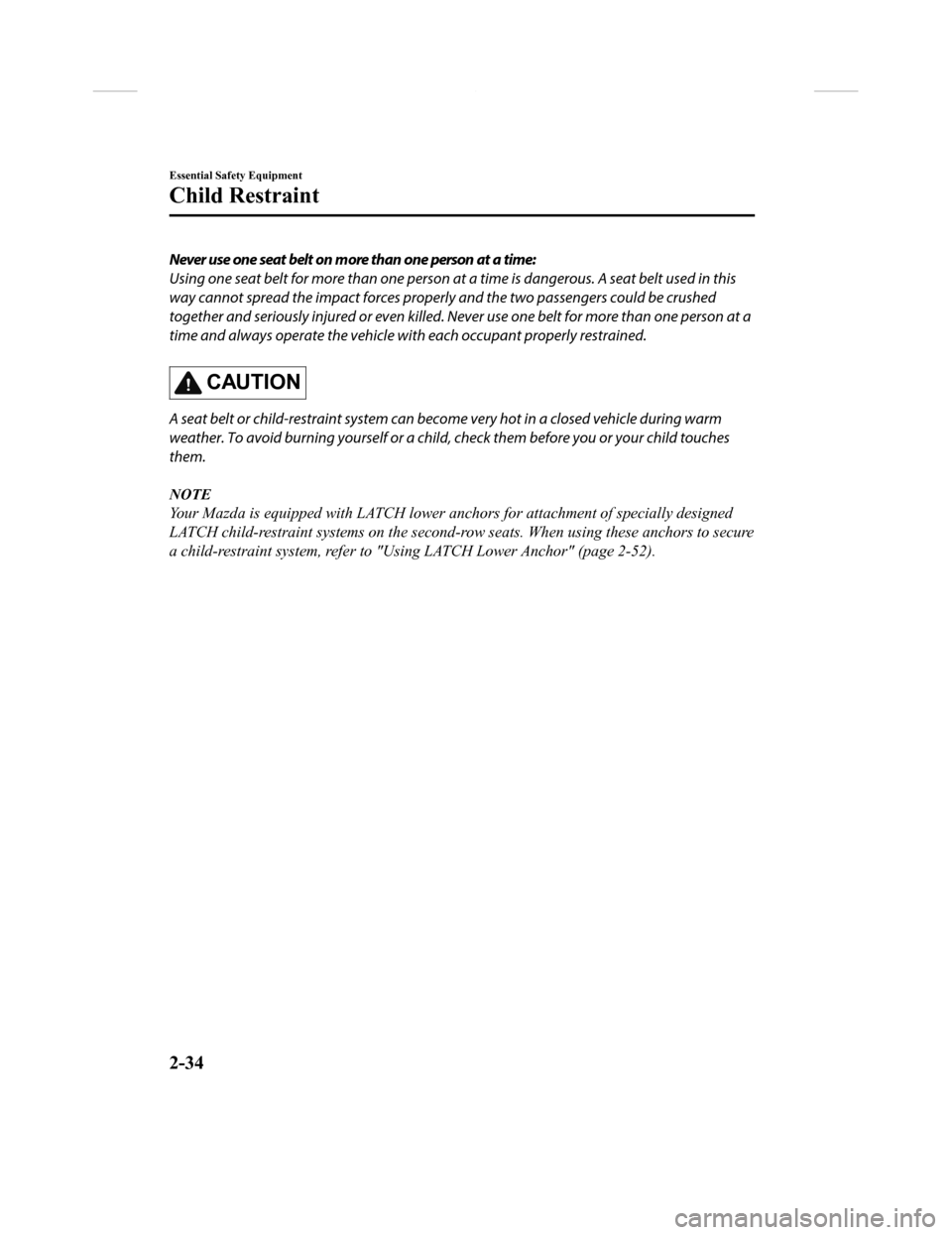
Never use one seat belt on more than one person at a time:
Using one seat belt for more than one person at a time is dangerous. A seat belt used in this
way cannot spread the impact forces properly and the two passengers could be crushed
together and seriously injured or even killed. Never use one belt for more than one person at a
time and always operate the vehicle with each occupant properly restrained.
CAUTION
A seat belt or child-restraint system can become very hot in a closed vehicle during warm
weather. To avoid burning yourself or a child, check them before you or your child touches
them.
NOTE
Your Mazda is equipped with LATCH lower an chors for attachment of specially designed
LATCH child-restraint systems on the second-row seats. When using these anchors to secure
a child-restraint system, refer to "Using LATCH Lower Anchor" (page 2-52).
Essential Safety Equipment
Child Restraint
2-34
CX-9_8GC3-EA-17G_Edition1 2017-5-29 10:13:38